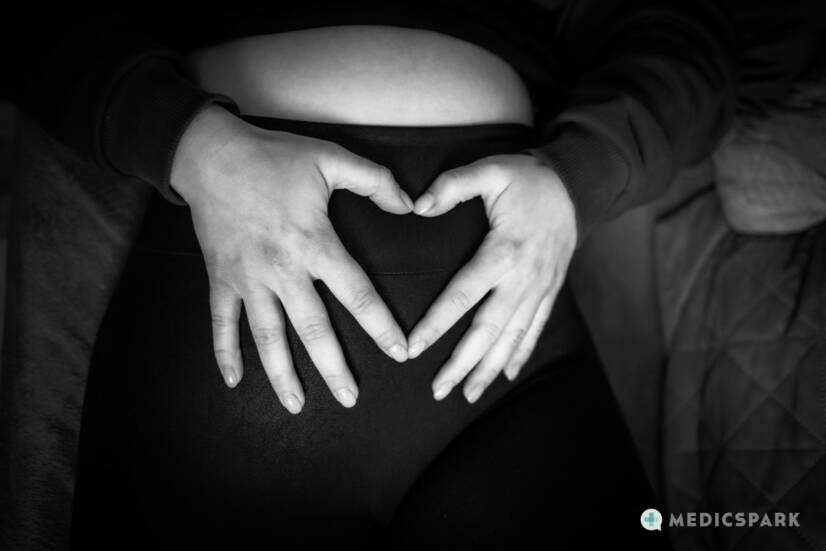- crohnika.sk - Portal focused on Crohn's disease and ulcerative colitis
- healthline.com - What's Causing Your Abdominal Bloating and Lower Abdominal Pain?
- patient.info - What's causing your pelvic pain?
- health.clevelandclinic.org - What's Causing Your Lower Abdominal Pain
The 10 most common reasons for lower back pain: do you know the causes?

Pain in the lower abdomen is one of the most common health problems. This non-specific symptom has various causes, from typically female problems to digestive problems to sudden abdominal accidents. Let's take a look at the most common ones together.
Article content
Let's look at the disorders and diseases that provoke hypogastric pain.
1 Menstrual pain
Menstrual bleeding is a natural part of every woman of childbearing age. Unfortunately, most women experience a not entirely uneventful course.
Dysmenorrhea (pain during menstruation) afflicts a number of women each month. These pains are caused by the hormone prostaglandin, which produces a spasmodic contraction of the uterus and a separation of its inner lining.
This action is accompanied by bleeding and pain. These are crampy, spastic and can radiate from the lower abdomen to the groin and back.
The pain is compounded by indigestion, as this hormone causes increased bowel movements. In addition to pain, nausea, vomiting and intestinal distress are common problems during menstruation.
During menstruation, many women experience weakness and dizziness. This is due to the sudden loss of fluids that accumulate in the body a few days before the onset of menstrual bleeding.
These discomforts are usually not the result of any disease. They are also often referred to as primary dysmenorrhea. Another case is secondary dysmenorrhea, which may be a symptom of a specific disease.
Therefore, if you feel that you are bleeding excessively or have unreasonably severe pain, consult your gynaecologist.
Possible causes of secondary dysmenorrhea:
- Endometriosis
- cysts on the ovaries
- inflammatory diseases of the uterus
- tumour
- polyps - growths of the mucous membrane
- adhesions - abnormal connections between tissues, for example after surgery
How to relieve pain during menstruation
Painkillers, warm compresses, bed rest and plenty of fluids can be helpful during menstruation.
Regular exercise, exercise and dietary modification have proved to be effective preventive measures against painful and heavy menstruation for more women. Avoid fatty, fried and overly salty foods. Limit coffee drinking, smoking and ensure adequate drinking.
For more advice and information, see:
Painduring menstruation
Excessive bleeding during menstruation
2 Pregnancy
In addition to the regular monthly pain that a woman may experience, there are other causes of unpleasant pain in the lower abdomen. This is often due to pregnancy itself.
Pain in the lower abdomen is one of the first signs of pregnancy. It can be similar to menstrual pain.
Occasional stabbing or pulling pains are also common. In the later stages, the pain is caused by the enlarging uterus and the pressure it puts on the surrounding organs and spine.
In the last trimester, these contractions may be called Braxton-Hicks contractions. They are also called messenger contractions and serve as training and preparation for the birth itself. They differ from real contractions in intensity and irregularity.
A separate chapter in the context of pain and pregnancy is ectopic pregnancy.
Pregnancy is a sensitive matter and any concerns are natural. Therefore, if in doubt, consult your gynaecologist. Give yourself plenty of rest, rest, a balanced diet and fluids.
Read more in our magazine article:
Are youpregnant and suffering from lower abdominal pain?
3 Inflammation of the female genital organs
Inflammatory diseases of this kind occur quite often. They can be inflammation of the vagina, uterus or ovaries, which usually occur together with inflammation of the fallopian tubes.
Causes or triggering factors include childbirth, miscarriage, promiscuous lifestyle and poor intimate hygiene, previous operations in the small pelvis (e.g. ovarian surgery for cysts, etc.).
Triggers of infection are most often bacteria or chlamydia.
Frequent and untreated inflammation can also be responsible for permanent infertility.
In addition to pain in the lower abdomen, symptoms include temperature, fatigue, disturbances in the menstrual cycle or discharge of foul-smelling mucus from the vagina.
Read more about vaginal discharge
or the article
Protect yourself from ovarian inflammation during pregnancy
4 The appendix
Perhaps the most common cause of lower abdominal pain that people think of when this topic comes up is appendicitis. Appendicitis, as it is professionally called, is actually a fairly common cause of painful sensations in the lower abdomen.
The exact name for the disease is inflammation of the worm-like appendix of the appendix - appendix vermiformis. The nature of the pain, however, is not always quite so clear-cut and directional.
Initially, it appears in the navel area, later moving to the right lower abdomen. However, often there is pain in other places.
The appendicular process can have variations in its location in many people. Moreover, the appendicular process is loose and can therefore have different positions. Thus, the symptoms of appendicitis can be varied.
To learn more about appendicitis, see the article:
How to recognise appendicitis
5 Inflammation of the urethra and bladder
Urethritis affects the female sex on average more than the male sex. Approximately one in two women will encounter these difficulties at least once in her lifetime.
The reason for this is the shorter urethra, which means that the bacteria that most often cause inflammation have a shorter route to the sites where they cause inflammation.
In addition to the typical symptoms, such as frequent urination of small amounts of urine, accompanied by cutting and burning, there is also pain in the lower abdomen.
Urinary tract inflammation is most often caused by Escherichia coli bacteria. Although these bacteria are naturally found in the rectum, they cause inflammation in the urinary tract.
Failure to treat or under-treat lower urinary tract infection can easily cause complications and worsening of the condition. Inflammation can spread from the bladder to the ureters and kidneys. This is when the condition often requires a hospital stay, with the need for infusion treatment with antibiotics.
Read also our magazine article:
Urinary tract infections are particularly troublesome in summer for the fairer sex
6 Diverticulitis
It is an inflammatory disease of the colon. It is a complication of a disease called diverticulosis.
The name derives from the word diverticulum, which is a bulge in the intestine. The origin is not fully understood, but it is mainly a combination of a weakened intestinal wall and the action of increased pressure in the intestine. It is therefore related to improper diet and frequent constipation.
These bulges can become inflamed due to several factors and cause pain, particularly in the left lower abdomen, which is when we speak of diverticulitis.
It occurs mainly in people over 60 years of age. It most often affects the esophageal part of the colon.
In some cases, the bulge may rupture, i.e. the wall of the bowel may rupture. This condition requires immediate surgery.
Read more about this disease, its causes and complications in the article on diverticulosis.
Do you suffer from frequent hard stools? The table lists suitable and unsuitable foods for constipation
| Do not eat when constipated | When constipated, the following will help |
| black tea | probiotic yoghurt, kefir |
| white flour | lemon, apples, figs, dates |
| alcohol | fibre, legumes |
| fried foods | honey |
| bananas | flaxseeds |
| rice | warm water |
| black tea | plums |
Read also an interesting article:
What is the right diet for diarrhea, constipation or vomiting?
Do you experience periods of diarrhoea and constipation,
accompanied by abdominal pain?
Read the article: Irritable Bowel Syndrome.
7 Crohn's disease and ulcerative colitis
Crohn's disease and ulcerative colitis are among the diseases of the digestive system that patients usually have to deal with for life.
These inflammatory diseases present considerable difficulties in everyday life. However, nowadays, modern treatment and adherence to certain principles bring an improved quality of life, without major limitations.
The causes are not fully understood. Both affect the intestinal system. Crohn's disease can affect the entire digestive tract, from the oral cavity to the rectum. Ulcerative colitis affects only the large intestine.
It presents with abdominal pain, diarrhoea, nausea, vomiting and, in ulcerative colitis, bloody stools.
Read also our magazine article: Stool - what should we know about it?
The intestines of such patients cannot digest gluten.
Those affected depend on a gluten-free diet.
Read about this disease in our magazine article:
Gluten-free diet.
8 Intestinal patency disorder
Ileus is the technical name for intestinal obstruction. It is also popularly called intestinal obstruction.
It occurs when there is an obstruction or other disturbance in the intestine that prevents peristalsis.
Peristalsis is the natural movement of the intestine to move its contents.
The table below shows the types of bowel obstruction:
| Ileus | Cause |
| Mechanical | Obstruction Stricture Foreign body, e.g. gallstone, part of stool |
| Neurogenic | disruption of nerve signals between nerves and muscle in the intestine |
| Vascular | disruption of blood flow to the intestines |
Symptoms depend on what kind of ileus it is. Most of the time it is a severe pain in the lower abdomen, vomiting, gas and stool retention. The symptoms also depend on whether it is a complete or partial ileus.
There can be many causes.
Read about them in the article: Ileus.
9 Hernia
Ahernia, as hernias are otherwise called, is a bulging of the peritoneum. The peritoneum is the membrane that covers the abdominal organs.
Often, a part of the intestine gets through such a weakened place in the abdominal wall. This is dangerous, especially if it is pinched. Then there is a disruption of its blood supply and a risk of necrosis - death of the intestine.
This can lead to peritonitis, a life-threatening condition.
10 Flatulence
The feeling of a bloated abdomen or flatulence is experienced by many people from time to time. It is also known professionally as flatulence and can really cause a lot of pain for some individuals.
It is often accompanied by abdominal pain, a feeling of overflowing bowels, and even passing wind through the rectum. It is called flatulence. Although it is a natural occurrence, it is socially inappropriate and embarrassing.
We speak of morbid flatulence when more than 25 winds escape during the day. The main causes include inappropriate eating habits and poor intestinal microflora.
You may also be interested in the article on probiotics.
Interesting resources










